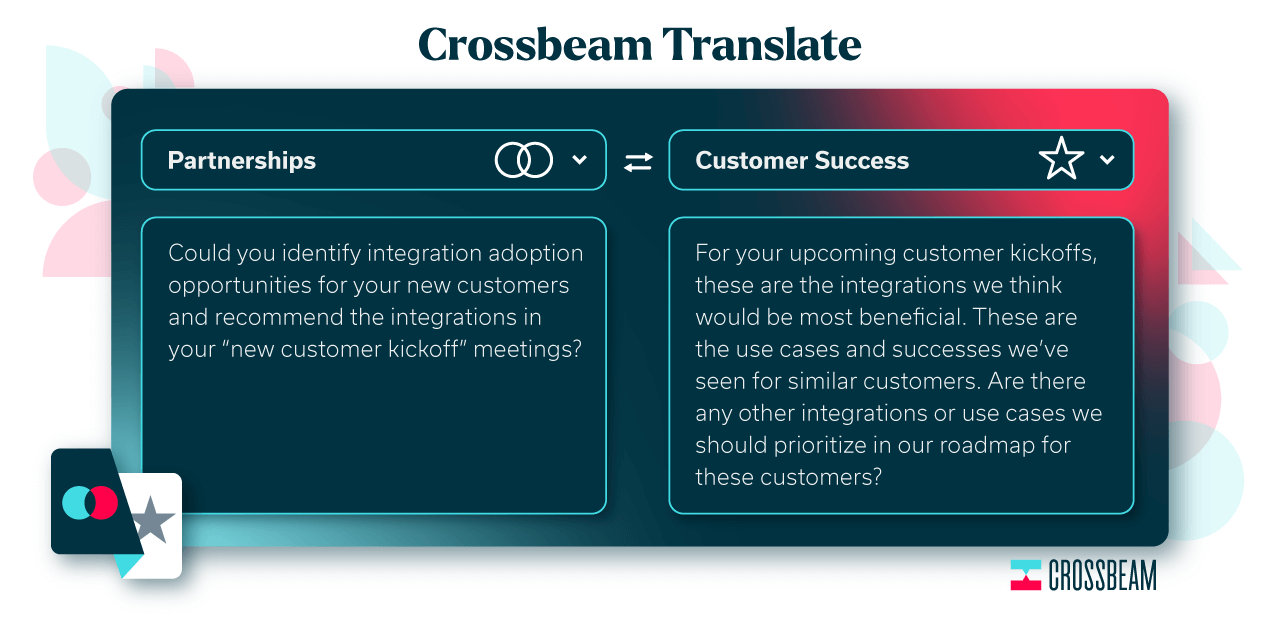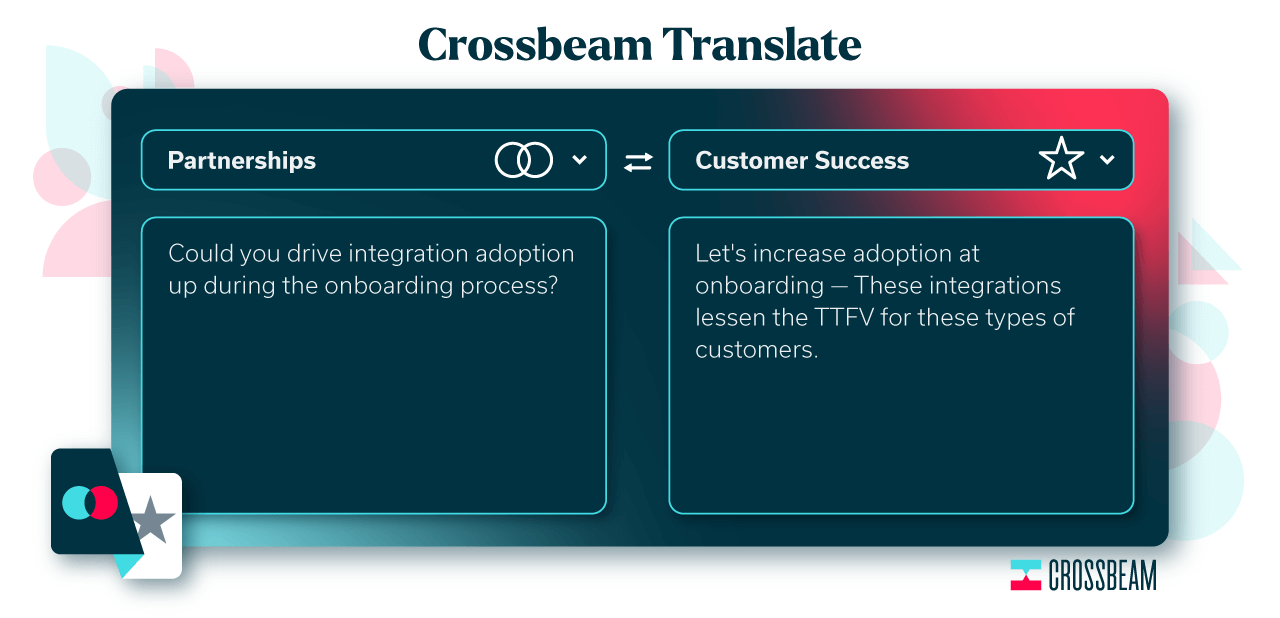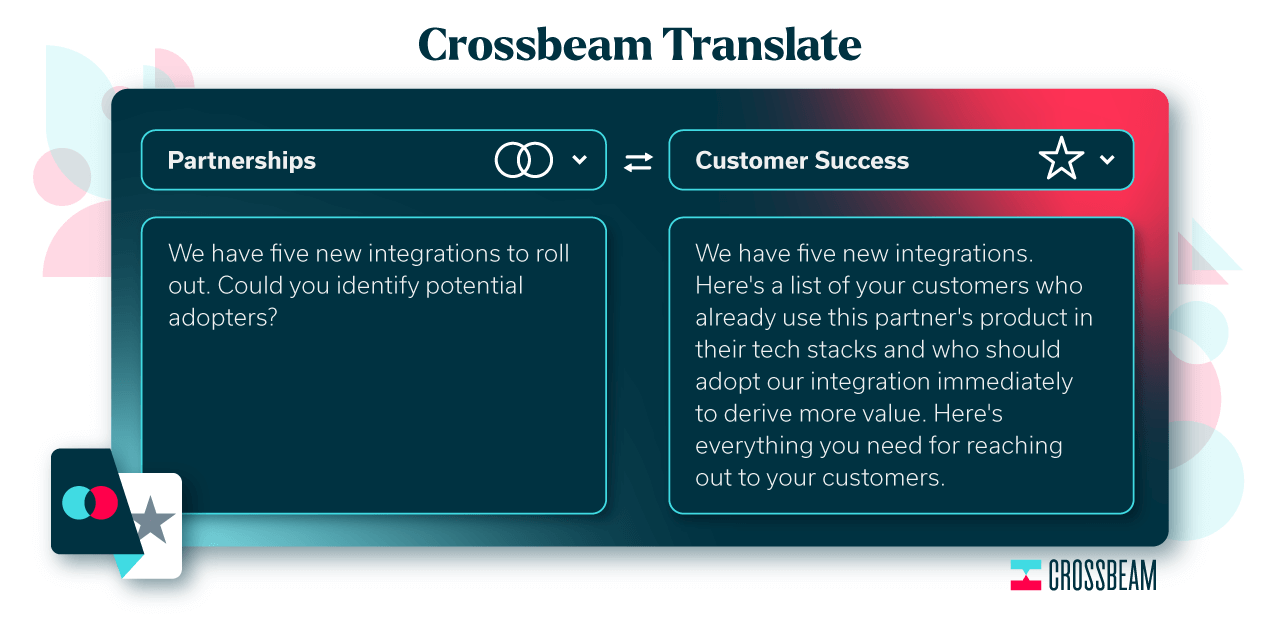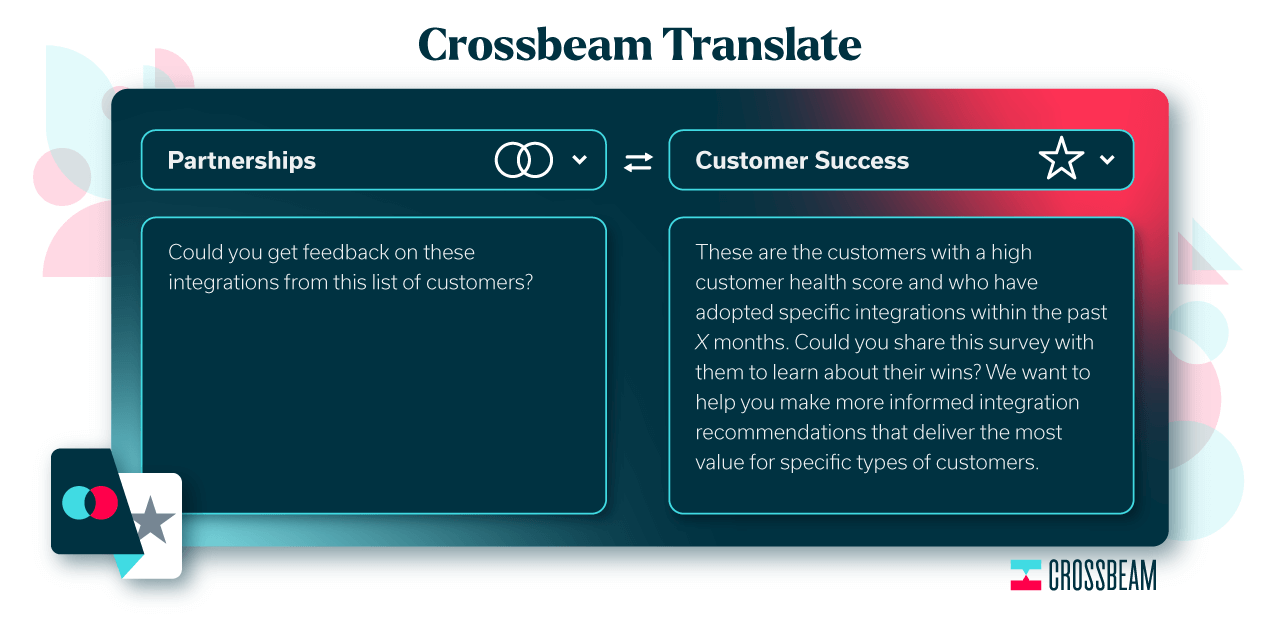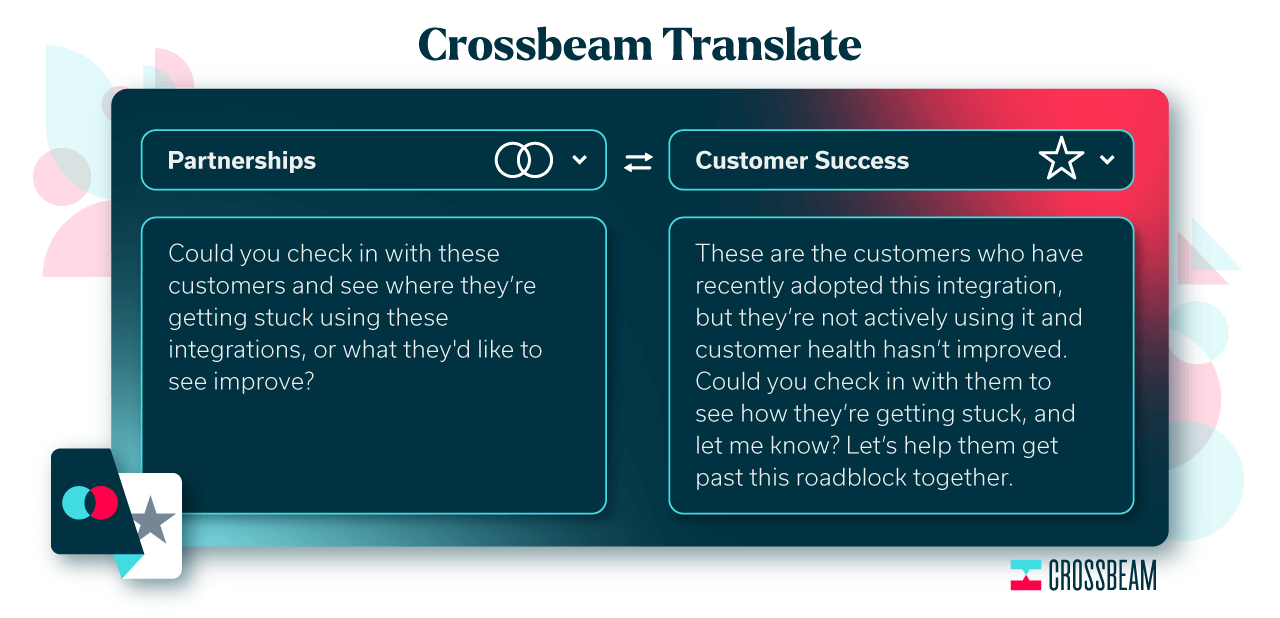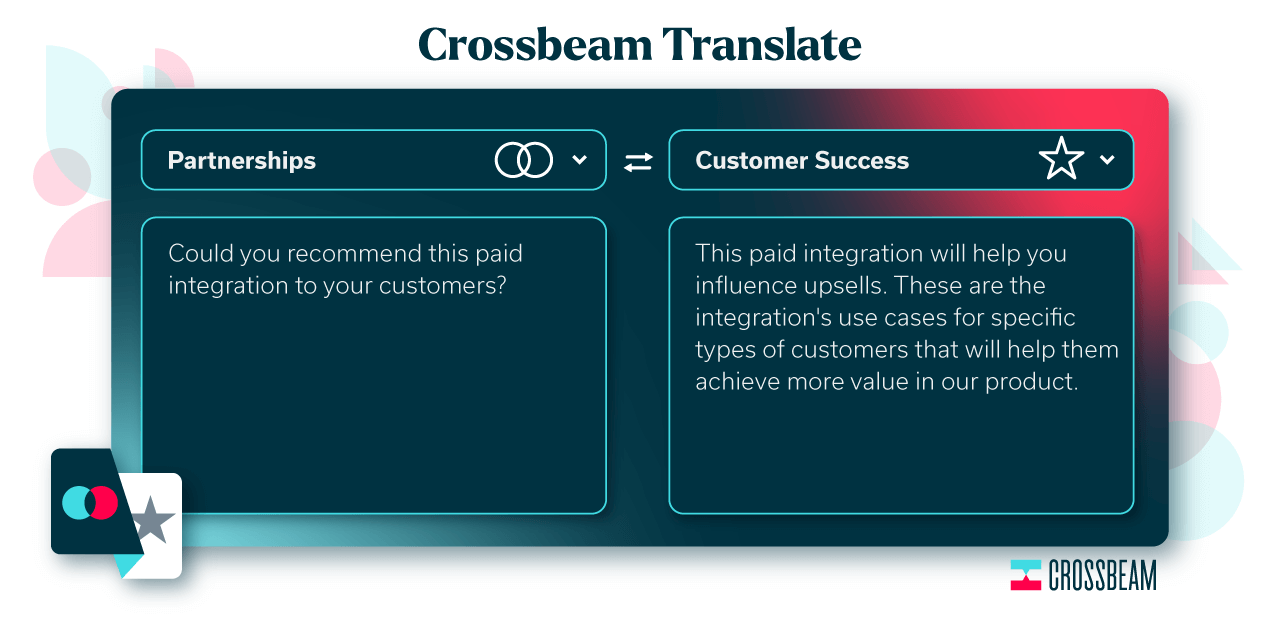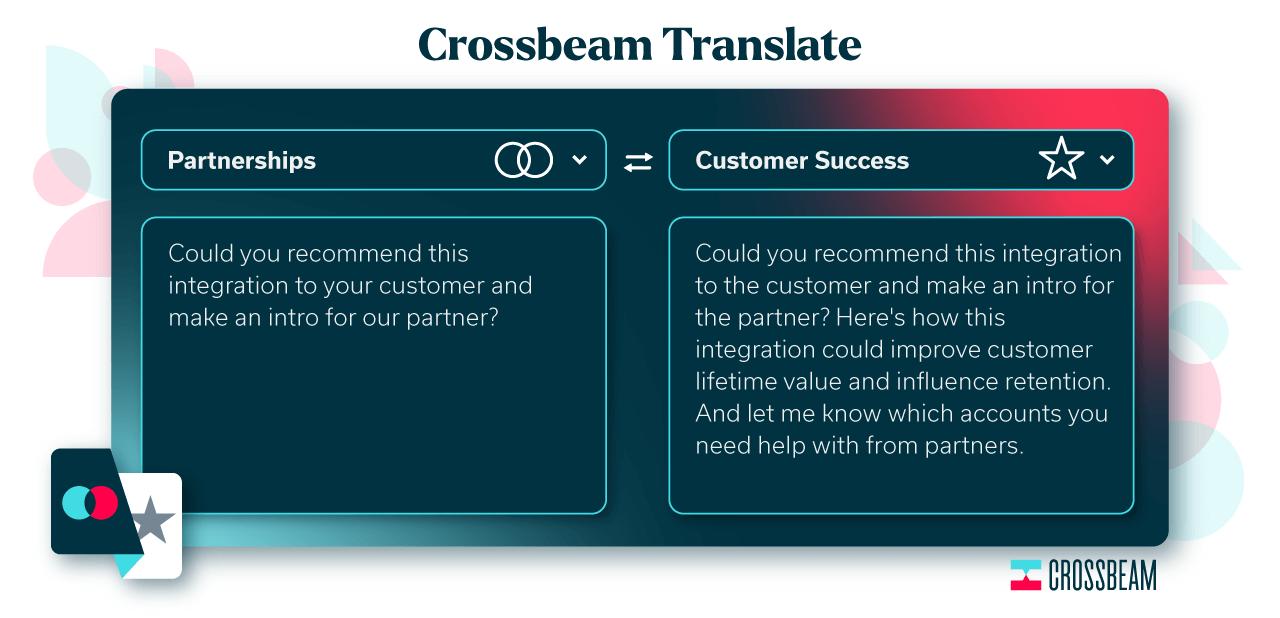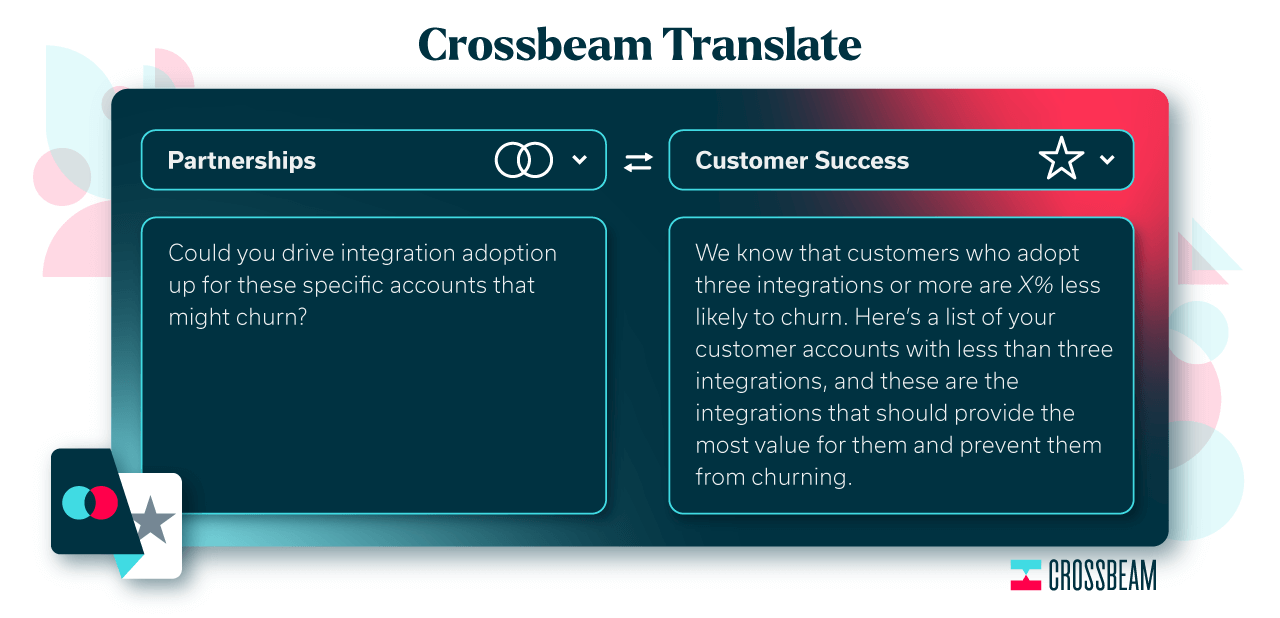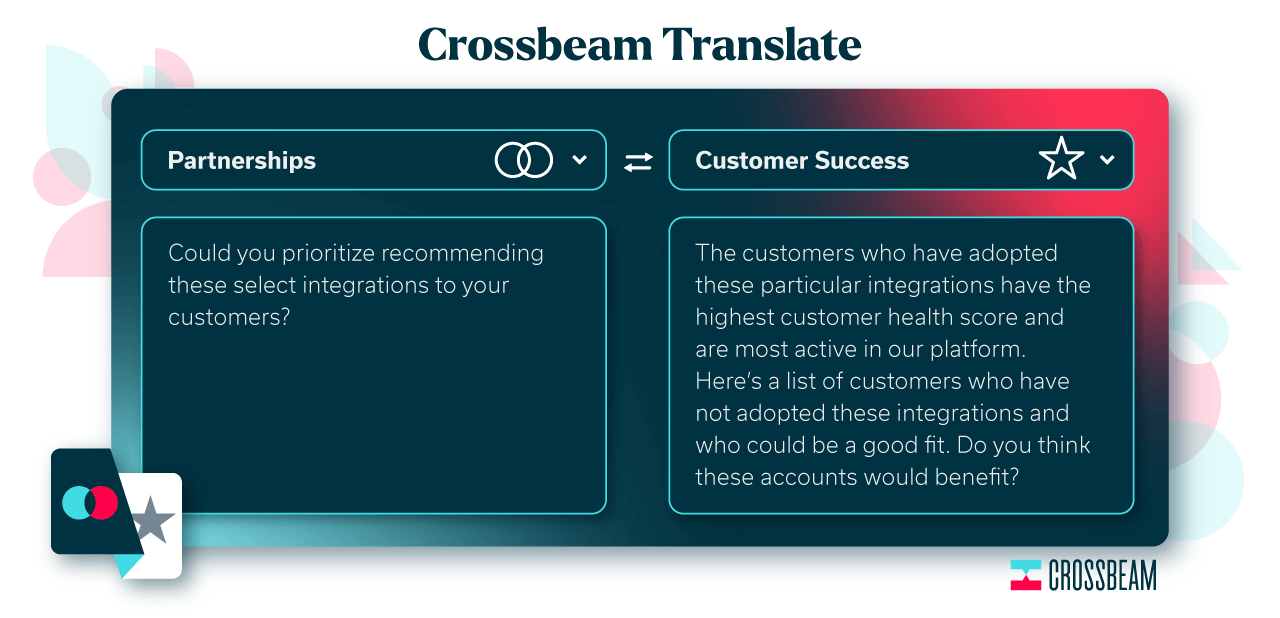This is Part Two in a series on effective communication with cross-functional teams. Read Part One, “How to Communicate Effectively With Your Sales team About Partnerships” here.
—
You start typing a message to your customer success manager (CSM). You’re struggling to find the right words and end up with two options sitting in your Slack draft. You turn to your cat and say, “Which of these is better?”
Option A: Hey, Amy, we need to drive these integration adoption numbers up among your customers.
Option B: Hey, Amy, I’ve pulled together a list of your customers who are actively using our partner’s product (I checked with the partner and confirmed!). I know some of these are new customers… This integration will help them get to value faster.
Your cat gives you a look of disdain. “Obviously, the second one. And where are your pleases and thank you’s?”
Option B clearly shows how your request will help your CSM hit specific goals tied to their key performance indicators (KPIs) and that you have their customers’ needs top of mind. (Skip ahead for a primer on common customer success KPIs.)
If you’re struggling to get buy-in, know this: Sometimes all it takes to establish a genuine camaraderie between your team and your CS team is a simple communication shift.
On getting buy-in in her first 90 days at Hawke Media, Ashley Scorpio, Senior VP of Partnerships, says, “It’s more like ‘What can I do for you? I’m here to help. How can I support you? How can partnerships add to this initiative or help improve upon it?’”
As your partner program matures, the results will speak for themselves, and your tech ecosystem will directly impact the entire business.
Jai Shroff, Senior Customer Success Manager at Freshworks, says working with partners has helped his team retain customers who were likely to churn, upsell the accounts for more annual recurring revenue (ARR), and sign them for multi-year deals.
“If your company is scaling, let’s say north of $100M in ARR, partnerships is the only way to reach that billion dollar dream. Inside sales is not going to get you there,” says Shroff.
We’ve developed a little exercise to help you communicate the value of partnerships more effectively and get your entire team driving adoption. Get your pen and paper ready.
To note: Depending on the size and structure of your company’s org chart, the CS role may encompass onboarding and quota-related responsibilities. For the purpose of this blog post, we’re treating the CS role as one who handles the onboarding process, manages the remainder of the customer lifecycle, and supports upsells and expansions.
–
The partnership ask: “Could you identify integration adoption opportunities for your new customers and recommend the integrations in your “new customer kickoff” meetings?”
What your customer success team thinks: How do I actually ensure this effort will provide value to the customer? Are the integrations critical to the onboarding process, or will they distract from helping the customer hit their first milestone? Which integrations are best to recommend?
What you should say instead: For your upcoming customer kickoffs, these are the integrations we think would be most beneficial. These are the use cases and successes we’ve seen for similar customers. Are there any other integrations or use cases we should prioritize in our roadmap for these customers?
Tip:
Bring thoughtful integration recommendations to your CS team to help them prepare, and listen carefully to their feedback. Show how you can provide value through integrations at onboarding and throughout the customer lifecycle. The earlier you can drive adoption for your customers, the more value they’ll get out of your product, and the longer they’ll stay.
If your CS team manages the onboarding process for new customers, sync with each CSM to discuss their upcoming “customer kickoff meetings”. Help them determine which integrations could have the biggest impact on each of their new customers’ first 30-90 days using your product. Make sure your CS team has success stories, case studies, and all of the information they need to effectively communicate how the integration will help the customer achieve their business goals.
You and your CS team should also discuss opportunities to bring more value to the customer leading up to their quarterly business reviews (QBRs). Use these meeting markers to discuss internally where the customer is or may be experiencing friction using your product and how relevant partners can help improve their experience, bring more value, prevent churn, and influence upsells and expansions.
–
The partnership ask: “Could you drive integration adoption up during the onboarding process?”
What your customer success team thinks: This is potentially a big ask on top of my regular responsibilities. Should this actually be my priority? I’ll need to spend extra time identifying the best integrations to recommend, on top of the adoption I already drive. And how can I be sure the additional integrations will add value and not distract from the customers’ goals?
What you should say instead: Let’s increase adoption at onboarding — These are the integrations that lessen the time-to-first-value (TTFV) for these types of customers. For example, for your customers in the “customer data platform” category, this is how we’re seeing successful integration usage. And for customers using X, Y, and Z tools in their tech stacks, these are the use cases we’re seeing. Let me know if there are any other use cases we should prioritize, or how I can help support your new customers hitting their first milestones.
Tip:
Identify customers who have seen success hitting specific milestones in your product using integrations, and help your CS team replicate those successes for other customers in the same category. If managing the onboarding process is part of your CSMs’ responsibilities, then they’re actively working to help their new customers complete specific activities and achieve their first business goals using your product. Identify integrations that can help support hitting those milestones. Listen to feedback from your CS team about each customer’s pain points and needs, and prioritize recommending, building, and customizing integrations that can help solve pain points for your CSMs and their customers.
You can also work with your leadership team to implement an “integration adoption” KPI to ensure new customers adopt a specific number of integrations within their first X days of using your product. When you have metrics around how integration adoption impacts churn and retention, use the data to make the case for integration adoption at specific stages of the customer lifecycle.
–
The partnership ask: “We have five new integrations to roll out, could you identify potential adopters?”
What your customer success team thinks: I’ve already provided feedback about my customers’ pain points. Do these integrations resonate with those customers? How can I quickly identify which customers will benefit most? It would be great to have support in this process.
What you should say instead: We have five new integrations. Here’s a list of your customers who already use this partner’s product in their tech stacks and who should adopt the integration immediately to derive more value from our product. Here’s everything you need for reaching out to your customers, including documentation, one-sheets, and snippets for outreach.
Tip: Map accounts with the partners you have new integrations with to identify which of your customers are also customers of your partners. Then, segment the list of overlaps by assigned CSM and give the list to each CSM so they can drive adoption immediately.
–
The partnership ask: “Could you get feedback on these integrations from this list of customers?”
What your customer success team thinks: What is this feedback for? I need to limit my outreach to customers and prioritize specific activities that will improve value for them and help me hit my goals.
What you should say instead: These are the customers with a high customer health score and who have adopted specific integrations within the past X months. Could you share this survey to learn about their wins and gather additional feedback? We believe adoption of these integrations has a positive correlation with customer health and want to give you more data-backed integration recommendations to drive value for specific types of customers.
Tip: Identify correlations between integration adoption and customer health, and use your analysis to help your CS team make more informed integration recommendations. Customer health is a KPI your CS team is consistently working to improve among all of their customers. Show them how integrations can help them reach achieve their goals.
–
The partnership ask: “Could you check in with these customers and see where they’re getting stuck using these integrations, or what they’d like to see improve?”
What your customer success team thinks: I’ve already sent my customers multiple emails about these integrations. Are these integrations actually causing issues in the product rather than helping them?
What you should say instead: These are the customers who have recently adopted this integration, but they’re not actively using it and customer health hasn’t improved. Could you check in with them to see how they’re getting stuck, and let me know? They’re using our partner’s product and should be getting value immediately. Let’s help them get past this roadblock together. And then I’ll provide feedback to the team to improve documentation for the integration and adjust our enablement materials.
Tip: Observe customer health and product usage following integration adoption. Use this analysis to uncover customer pain points when adopting specific integrations and to improve documentation, communication, and the integration itself.
Collaborate with your CS team to ensure your customers are benefiting as they should from using the integration. Provide your CSMs with insights about how adoption is impacting customer health so they can provide the best support to their customers and deliver the value specific integrations promise.
–
The partnership ask: “Could you recommend this paid integration to your customers?”
What your customer success team thinks: What kind of value will this integration provide my customer? I want to be careful not to break the trust we’ve built by recommending a paid integration that doesn’t resonate with them.
What you should say instead: This paid integration will help you influence upsells. These are the integration’s use cases for specific types of customers that will help them achieve more value in our product.
Tip: Recommending a paid integration to the wrong customers can sour the relationship between your CSMs and their customers. Map accounts with your partners to understand which customers are already using your partners’ products. You can also check in with your partners to understand the customer health of their customers using their product.
Customers who have a healthy customer health score with your partner can benefit immediately from adopting the integration. Provide your CSMs with integration use cases and success stories that they can apply directly to supporting these particular customers.
–
The partnership ask: “Could you recommend this integration to your customer and make an intro for our partner?”
What your CS team thinks: How will this particular integration benefit my customer? Will introducing the partner have a negative impact on the trust I’ve built with my customer? How often should I help partners when they ask?
What you should say instead: Could you recommend this integration to your customer and make an intro for the partner? Here’s how this integration could improve customer lifetime value (CLV) and retention. And let me know which accounts you need help with from partners.
Tip: If your partner or their sales rep asks for an intro into your customer account or support from your CSM, make sure the integration is a good fit for the particular customer first. If it is, make the case to your CSM so they know how the customer will benefit and can genuinely vouch for your partner.
Depending on the maturity of your tech ecosystem, chances are your CSM has seen some of their customers use the integration successfully and will be able to reference their own observations to the customer.
After your CSM makes the intro or provides your partner with context about the account, ask your CSM for feedback about the meeting. Was the interaction with your partner or their sales rep successful? Did the CSM feel the intro to the customer made sense? If the customer adopts the integration and buys your partner’s product, did the customer get value? Use your CSMs’ answers to adapt your co-selling process accordingly.
–
The partnership ask: “What kinds of integrations will solve your customers’ current pain points?”
What your customer success team thinks: Will my feedback actually make it into our product roadmap? When will the integrations my customers need most get launched? Which types of customers can you help support in the immediate future?
What you should say instead: What are the pain points your customers are experiencing? What kinds of integrations would you like to see? Let’s work together to drive adoption and account expansions for a list of your accounts.
Tip: Ask your CSMs where they need the most help supporting their customers. Understand their customers’ pain points, and adjust your roadmap to meet their needs. Your CS team should be your first source of truth for the development of your tech ecosystem. Look to them to help fill product gaps and increase value.
And get specific. Have your CSM choose a list of accounts they need help with, and discuss how you can support them. Or come to your CSM with a list of accounts that have specific needs, unique tech stacks, or customer health and product usage metrics. Then discuss how the adoption of specific integrations can drive more value for the accounts or the kinds of integrations your CS team envisions helping their customers in the future.
–
The partnership ask: “Could you drive integration adoption up for these specific accounts that might churn?”
What your customer success team thinks: I need to be careful about what I recommend to these customers. How will these particular integrations provide enough value to influence my customers to stay?
What you should say instead: We know that customers who adopt three integrations or more are X% less likely to churn. Here’s a list of your customer accounts with less than three integrations, and these are the integrations that should provide the most value for them and prevent them from churning.
Tip: Analyze your tech ecosystem’s impact on churn, and use the data to determine which customers are most likely to churn. Look at customer health scores, integration adoption numbers, and more to make the case to your CSM.
The right integrations can lead to not only more value for the customer but also an even greater annual recurring revenue (ARR) and a multi-year deal!
–
The partnership ask: “Could you prioritize recommending these select integrations to your customers?”
What your customer success team thinks: We have new integrations every month. How can I stay on top of recommending the best possible integrations to my customer list as our ecosystem grows? Which customers will benefit most from these particular integrations?
What you should say instead: The customers who have adopted these particular integrations have the highest customer health score and are most active in our platform. Here’s a list of customers who have not adopted these integrations and who could be a good fit. Do you think these accounts would benefit?
Tip: Determine which integrations lead to the highest customer health scores and to increases in product usage, and share the data with your CS team. For each CSM, generate a list of accounts who have not adopted the integration but would find value and suggest your CSM reach out to the accounts to improve CLV. Knowing these integrations lead to the most successful customers is important intel for your CS team. These integrations will become your CSMs’ go-tos when discussing many of their customers’ goals.
–
A quick primer on common customer success KPIs (and how you should think about them)
If you’re trying to show the value of partnerships to CSMs who haven’t worked with partners before, start by listening. Gather feedback and deliver results that resonate by:
- Asking your CSMs about their pain points (like issues helping customers complete specific activities in your product)
- Asking your CSMs about their customers’ pain points (like customers wishing they could use data from your product in specific ways)
- Identifying and building integrations that could solve these pain points
- Introducing the integrations to specific customers as early adopters, gathering more feedback, and improving upon your tech ecosystem as you roll out more integrations and integration functionalities
- Continuing to poll your CSMs for feedback and building out those integrations and integration functionalities
As your tech ecosystem grows, treat your CS team’s feedback as your first source of truth, and build their needs into your ecosystem roadmap (read: co-design).
The right partnerships will directly contribute to your CS team hitting the goals tied to their KPIs. It’s important to know what those KPIs are and how your tech ecosystem will support them.
Common customer success KPIs:
Churn and Retention… Think: how your integrations can swoop in to prevent customers who are likely to churn, or how customers who adopt a certain number of integrations find more value and are less likely to churn.
Customer Lifetime Value (CLV)… Think: How specific integrations, combinations of integrations, or amounts of integrations contribute to ARR and longevity of the customer lifecycle.
Customer Health Score… Think: How specific integrations have influenced your customers to complete more positive activities (like increasing the frequency of specific feature usage) and to prevent negative activities (like decreasing the number of customer support tickets) while using your product.
Net Promoter Score (NPS)… Think: How likely your customers are to speak highly of your product and the integrations they use.
Customer Satisfaction Score (CSAT)… Think: How satisfied your customers are with their use of your product and relevant integrations.
Customer Support Tickets… Think: How specific integrations can lessen friction during the onboarding process and throughout the customer lifecycle. Smoother processes, less support tickets.
Monthly Recurring Revenue (MRR) and Annual Recurring Revenue (ARR)… Think: How specific integrations or amounts of integrations lead to retention, renewals, and upsells.
Engagement… Think: How integrations can make your product useful to additional stakeholders in the account, like cross-functional teams or leadership.
Time-to-first-value (TTFV)… Think: How specific integrations can help your customers achieve their first milestones using your product.
Integration Adoption… Think: partnership-related KPIs.
Account expansions and upsells (sometimes in collaboration with an account manager role)… Think: How paid integrations can lead to upsells and how specific integrations can help your team cross-sell and expand existing accounts.
–


